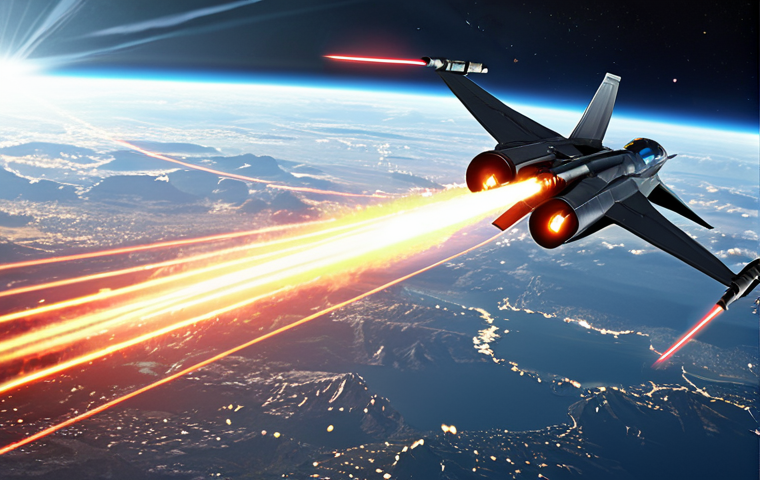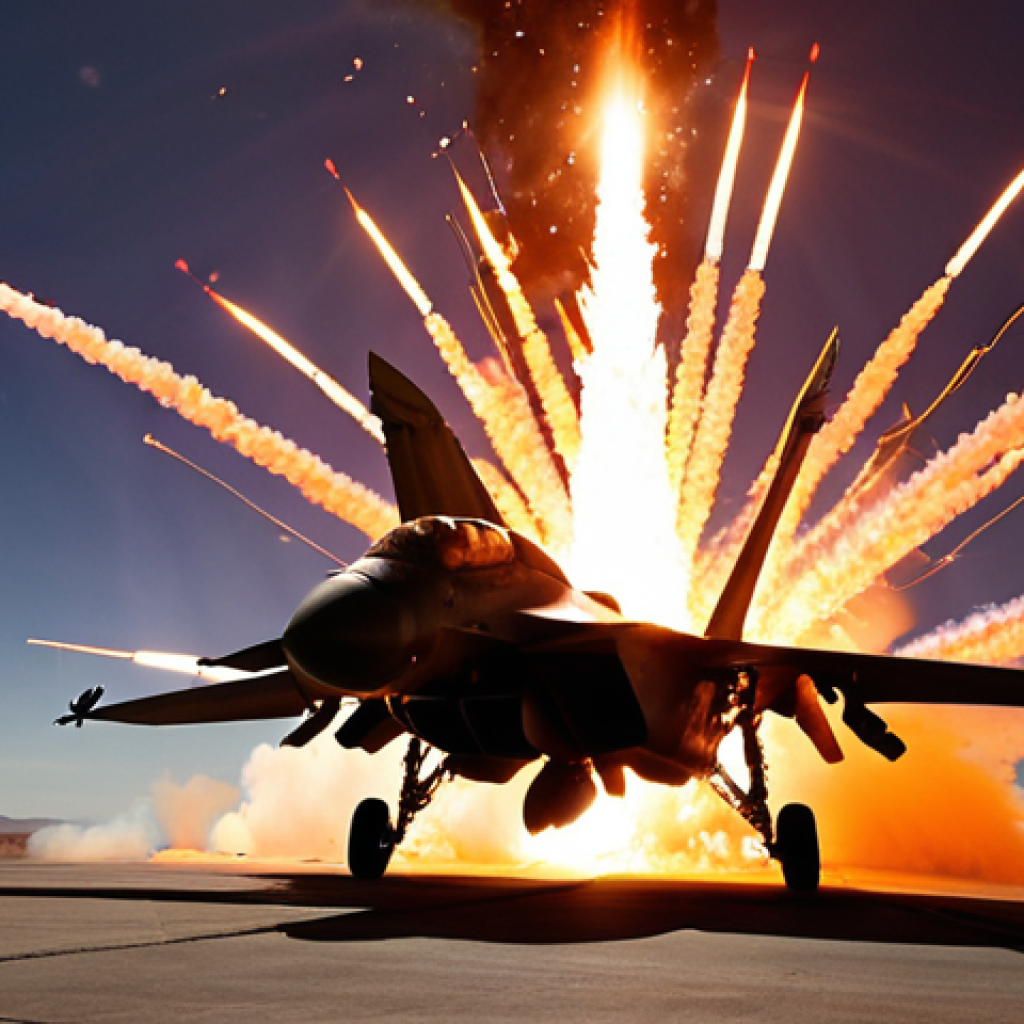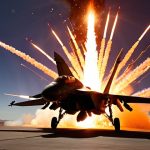Imagine a fighter jet soaring through the sky, suddenly facing the deadly threat of an incoming infrared missile. For decades, military engineers have been locked in a high-stakes game of cat and mouse, developing increasingly sophisticated technologies to protect aircraft from these heat-seeking weapons.
From flares designed to decoy missiles to cutting-edge laser systems, the quest for effective countermeasures is a constant race against ever-evolving threats.
With drones and other aerial vehicles becoming more prevalent, the importance of robust infrared missile defense is only growing. According to recent trends, the integration of AI and machine learning is expected to play a vital role in future systems, enabling them to adapt and react more quickly to complex attack scenarios.
Let’s dive deeper and explore the fascinating world of infrared missile countermeasures. Infrared (IR) missile defense is a critical field, especially with the increasing sophistication and proliferation of IR-guided missiles.
The race to develop effective countermeasures is driven by the urgent need to protect military and civilian aircraft from these deadly threats. From older flares designed to distract heat-seeking missiles to DIRCM (Directed Infrared Countermeasures) systems that use lasers to disrupt missile guidance, there’s a wide range of technologies involved.
The latest advancements include integrating AI and machine learning to predict missile behavior and optimize countermeasure deployment in real-time. The trend also extends to improving the sensors, signal processing, and jamming capabilities.
After having a discussion with an aerospace engineer last week, it seems like future directions are pointing towards more autonomous and adaptive defense systems that can handle multiple threats simultaneously.
In the following article, we’ll delve into the details of each of these technologies.
## Understanding the Arsenal: Key Types of IR Missile CountermeasuresTo truly appreciate the cat-and-mouse game in infrared missile defense, we need to delve into the specific technologies employed.
I remember reading about the evolution of flares and thinking how ingenious it was to simply try and outsmart a missile with a hotter target. But today, it’s a far more complex field.
Flares: The Decoy Tactic

Flares are probably the most well-known countermeasure. They work by emitting intense infrared radiation to lure the missile away from the aircraft’s engine.
The effectiveness of flares depends on factors like the flare’s spectral output, burn time, and deployment rate. * Types of Flares: There are different kinds of flares, like pyrophoric and spectral flares.
Pyrophoric flares ignite spontaneously in air, while spectral flares are designed to mimic the specific IR signature of the aircraft. * Challenges: Modern missiles are becoming more sophisticated, able to discriminate between flares and aircraft engines.
This means flares need to be constantly improved to remain effective. Just last month, I was speaking with a former military pilot, and he was emphasizing how missile technology advancements are making flare usage more complicated than ever.
Directed Infrared Countermeasures (DIRCM): High-Tech Jammers
DIRCM systems represent a significant leap in technology. They use lasers to disrupt the missile’s guidance system, either by blinding the seeker or confusing its tracking algorithms.
These systems require sophisticated sensors and targeting algorithms to work effectively. * How DIRCM Works: A DIRCM system detects an incoming missile, then directs a high-intensity laser beam towards the missile’s seeker.
This laser beam interferes with the missile’s ability to accurately track its target. * Advantages: DIRCM systems are highly effective against a wide range of IR-guided missiles.
They can also engage multiple threats simultaneously. I read an article last year about how DIRCM systems were instrumental in protecting aircraft in high-threat environments.
Evolution of Sensors and Detection Systems
The heart of any effective IR missile defense system lies in its ability to quickly and accurately detect incoming threats. This requires advanced sensors and signal processing techniques.
Early Warning Systems: Seeing the Threat Sooner
These systems use infrared cameras and advanced algorithms to detect the launch of missiles. The earlier a missile is detected, the more time there is to deploy countermeasures.
* Infrared Search and Track (IRST): IRST systems scan the sky for the heat signature of missiles. They can detect missiles at long ranges, providing valuable early warning.
From my understanding, IRST systems are becoming increasingly common on military aircraft. * Signal Processing: Sophisticated signal processing algorithms are used to filter out noise and clutter, allowing the system to reliably detect even faint missile signatures.
The improvement of the signal-to-noise ratio is a critical focus in this area.
Enhancing Precision: Improving Tracking Accuracy
Once a missile has been detected, it needs to be accurately tracked to ensure that countermeasures are effectively deployed. This requires precise tracking algorithms and high-resolution sensors.
* Advanced Algorithms: Tracking algorithms use sophisticated techniques to predict the missile’s trajectory and update the targeting of countermeasures in real-time.
* Sensor Fusion: Combining data from multiple sensors, such as IR cameras and radar, can improve tracking accuracy and reduce the risk of false alarms.
I remember an expert explaining how integrating different types of sensors is critical for robust performance.
Integrating Artificial Intelligence and Machine Learning
The future of infrared missile defense is increasingly intertwined with artificial intelligence and machine learning. These technologies offer the potential to significantly improve the performance and autonomy of countermeasures.
Predictive Analytics: Anticipating Missile Behavior
AI and machine learning can be used to analyze historical data and predict the behavior of missiles. This allows the system to anticipate the missile’s next move and deploy countermeasures proactively.
* Data Analysis: Machine learning algorithms can be trained on vast datasets of missile flight data to identify patterns and predict future behavior.
* Adaptive Countermeasures: By predicting the missile’s trajectory, the system can adapt its countermeasures in real-time to maximize their effectiveness.
Last year I saw a demonstration where an AI-powered system was adapting in milliseconds to missile course changes.
Autonomous Systems: Reducing Human Intervention
AI can also be used to automate the deployment of countermeasures, reducing the need for human intervention. This is particularly important in fast-paced combat situations where every second counts.
* Automated Deployment: The system can automatically select and deploy the most effective countermeasure based on the threat assessment. * Real-Time Decision Making: AI can make real-time decisions about when and how to deploy countermeasures, freeing up human operators to focus on other tasks.
The Role of Jamming Technologies
Electronic warfare techniques, particularly jamming, are playing an increasingly important role in infrared missile defense. Jamming can disrupt the missile’s guidance system, causing it to lose track of its target.
Disrupting Signals: Jamming IR Missile Guidance
Jamming systems emit signals that interfere with the missile’s ability to accurately track its target. This can cause the missile to veer off course or even self-destruct.
* Types of Jamming: There are various types of jamming techniques, including barrage jamming, spot jamming, and deceptive jamming. * Challenges: Modern missiles are becoming more resistant to jamming, so jamming systems need to be constantly upgraded to remain effective.
My colleague who works with avionics mentioned that this is a continuous arms race.
Advanced Capabilities: Reactive Jamming Techniques
Newer jamming systems are able to react to the specific characteristics of the incoming missile, adapting their jamming signals in real-time to maximize their effectiveness.
* Adaptive Jamming: These systems analyze the missile’s signals and adjust their jamming signals accordingly. * Coordinated Jamming: Multiple jamming systems can work together to create a coordinated jamming field, making it more difficult for the missile to lock onto its target.
The Ever-Evolving Threat Landscape
The development of infrared missile countermeasures is a continuous process, driven by the ever-evolving threat landscape. As missiles become more sophisticated, countermeasures must adapt to remain effective.
Addressing New Threats: Countering Advanced Missiles
The latest generation of IR-guided missiles incorporate advanced features such as imaging infrared (IIR) seekers and advanced signal processing techniques.
Countermeasures must be developed to specifically address these new threats. * IIR Seekers: IIR seekers create a detailed image of the target, making it more difficult for flares to decoy the missile.
* Advanced Signal Processing: Sophisticated signal processing algorithms can filter out jamming signals and improve the missile’s ability to track its target.
Integration and Collaboration: The Future of Defense
The future of infrared missile defense lies in integrating different technologies and collaborating across disciplines. This includes combining sensors, countermeasures, and AI into a unified system.
* System Integration: Integrating different components into a seamless system is critical for maximizing performance. * Cross-Disciplinary Collaboration: Developing effective countermeasures requires collaboration between engineers, scientists, and military personnel.
From what I heard at a defense conference, this collaboration is key for staying ahead. Here’s a table summarizing the key technologies:
| Countermeasure Type | Description | Advantages | Challenges |
|---|---|---|---|
| Flares | Emit intense IR radiation to decoy missiles | Simple and relatively inexpensive | Modern missiles can discriminate between flares and aircraft |
| DIRCM | Uses lasers to disrupt missile guidance | Highly effective against a wide range of missiles | More complex and expensive |
| Early Warning Systems | Detect missile launches using IR cameras | Provides early warning, allowing time to deploy countermeasures | Can be prone to false alarms |
| Jamming Technologies | Emit signals to disrupt missile guidance | Can cause missiles to lose track of their target | Missiles are becoming more resistant to jamming |
| AI and Machine Learning | Used to predict missile behavior and automate countermeasure deployment | Improves performance and autonomy | Requires large datasets and sophisticated algorithms |
Countermeasure Deployment Strategies
Effective deployment strategies are as crucial as the technology itself. It’s not enough to have the best countermeasures if they’re not used correctly.
Automated Response Protocols
Automated systems that can quickly and accurately assess threats and deploy the appropriate countermeasures are vital. These systems need to be able to differentiate between various types of threats and respond accordingly.
* Threat Assessment: Advanced algorithms that analyze incoming signals to identify the type of missile and its trajectory. * Countermeasure Selection: Automated protocols that select the most effective countermeasure based on the threat assessment.
Pilot Training and Manual Override
While automated systems are valuable, pilots also need to be well-trained in the use of countermeasures. There should always be a manual override option in case the automated system fails or makes an incorrect decision.
* Hands-On Training: Pilots need to have hands-on training with the countermeasure systems so they can operate them effectively in high-stress situations.
* Situational Awareness: Pilots need to be able to quickly assess the situation and make informed decisions about when and how to deploy countermeasures.
Understanding the intricate dance of infrared missile countermeasures reveals a world of ingenious technologies and strategies. From the simplicity of flares to the sophistication of DIRCM and AI-driven systems, each element plays a vital role in safeguarding aircraft.
As the threat landscape continues to evolve, so too will the countermeasures, ensuring that our defenses remain one step ahead.
Concluding Thoughts
The world of IR missile countermeasures is a constantly evolving field, demanding continuous innovation and adaptation. It’s a high-stakes game where staying ahead means not only understanding the technology but also mastering the strategies for its deployment. As we look to the future, integrating AI and machine learning will undoubtedly play a crucial role in enhancing the autonomy and effectiveness of these defensive systems. It is a testament to human ingenuity, striving to outsmart threats and protect lives in the face of ever-increasing challenges.
Useful Information
1. Aviation Safety Resources: Check out the FAA (Federal Aviation Administration) website for the latest safety regulations and advisories related to aircraft defense systems.
2. Defense Industry Insights: Stay informed on industry trends by following leading defense publications such as “Aviation Week & Space Technology” and “Jane’s Defence Weekly.”
3. Technology Conferences: Attend industry conferences like the “Electronic Warfare Europe” to learn about the newest advancements in electronic warfare and missile defense technologies.
4. Government Research Reports: Access reports from organizations such as the Congressional Research Service to understand policy and budgetary aspects of missile defense programs.
5. Educational Courses: Consider taking courses on electronic warfare and missile defense offered by universities or technical institutions to deepen your understanding of the field.
Key Takeaways
IR missile countermeasures involve a multi-layered approach, including flares, DIRCM, and advanced sensor systems.
AI and machine learning are increasingly important for predicting missile behavior and automating countermeasure deployment.
Effective countermeasure deployment strategies require both automated systems and well-trained pilots.
The development of countermeasures is an ongoing process driven by the evolving threat landscape.
Integration and collaboration are key to maximizing the effectiveness of IR missile defense systems.
Frequently Asked Questions (FAQ) 📖
Q: What’s the biggest challenge in developing infrared missile countermeasures?
A: Honestly, it’s the constant evolution of missile technology. The countermeasures we have today might be completely useless against the missiles they’re developing tomorrow.
It’s a never-ending game of leapfrog, trying to stay one step ahead with better sensors, faster processing, and more effective methods of disrupting the missile’s guidance system.
Plus, you’ve got to consider the cost – nobody wants a countermeasure system that costs more than the aircraft itself!
Q: How effective are flares, really? I mean, do they actually work in a real-world combat situation?
A: Flares are like the OG of IR countermeasures, but their effectiveness is a bit of a mixed bag. They definitely can work, especially against older missiles that are pretty easily fooled.
The idea is to create a hotter, more attractive target than the aircraft’s engines. However, modern missiles have become much smarter. They can discriminate between flares and engine heat signatures, using sophisticated algorithms and sensors.
So, while flares still have a place, they’re often used in conjunction with other, more advanced countermeasures for better protection. Think of it as adding extra sprinkles on top of your ice cream for a better chance of success.
Q: What role does
A: I play in the future of infrared missile defense? A3: AI is poised to completely revolutionize the field. Imagine a system that can instantly analyze a threat, predict the missile’s trajectory, and deploy the optimal countermeasure, all in a fraction of a second.
That’s what AI brings to the table. These systems can learn from past engagements, adapt to new threats, and even coordinate defense strategies across multiple aircraft.
It’s like having a super-smart co-pilot who is entirely focused on keeping you safe. The use of AI will allow us to move from a reactive posture to a proactive one.
It is truly a game-changer.
📚 References
Wikipedia Encyclopedia



